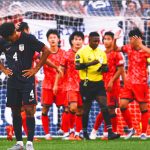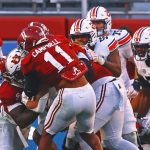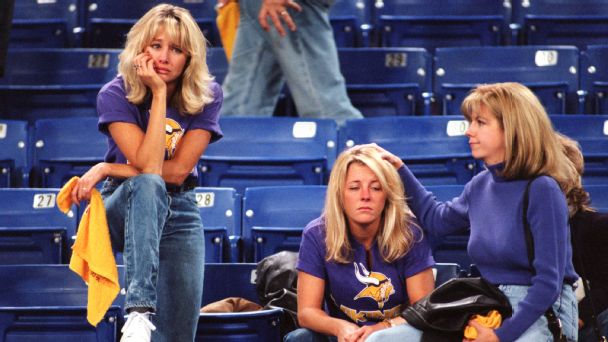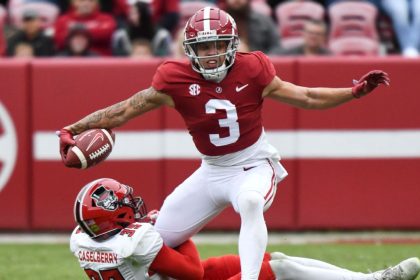
THE BALL SAILED off Gene Larkin’s bat and over the Atlanta Braves’ drawn-in outfield as teammate Dan Gladden jogged home to score the winning run of the 1991 World Series, the Minnesota Twins’ second championship in five seasons.
The notoriously raucous Metrodome, with a crowd of 55,118, erupted.
At that particular moment, there was so much to anticipate in Minnesota sports. The Twins appeared on the verge of a dynasty. The NHL’s North Stars were fresh off an appearance in the Stanley Cup Finals. The NBA had recently returned to the market after a 30-year absence, in the form of the expansion Timberwolves. Super Bowl XXVI was to be played in the Metrodome in January 1992, followed by the men’s basketball Final Four that spring and golf’s U.S. Open that summer.
“It was Minnesota sports Camelot,” said Twins president/CEO Dave St. Peter, an intern for the team in 1991.
Alas, the end of Camelot came quickly. Since that moment, none of Minnesota’s four major pro sports teams — MLB’s Twins, NBA’s Timberwolves, NHL’s North Stars (later the Wild) and the NFL’s Vikings — have advanced to a championship series or Super Bowl, much less won. The span of 32 title-free years, extended at times via comically unlikely scenarios, is the longest active streak among the nation’s 13 markets with all four leagues present. It’s a decade longer than the next-most starved market in Arizona.
The malaise, elevated further in the national sphere by the Detroit Lions‘ breakthrough 2023 season, has spread beyond Minnesota’s four major sports. The University of Minnesota’s football team has gone 56 years since winning the Big Ten title, and the NCAA vacated the sole Final Four appearance of its men’s basketball team because of a 1997 academic scandal. Only the WNBA’s Lynx has saved the pro market from a complete famine, appearing in six league Finals from 2011-17 and winning four titles, though in the “State of Hockey” it’s worth mentioning the men’s and women’s hockey teams from the University of Minnesota and University of Minnesota-Duluth have won a combined 16 NCAA championships since 1991.
Even the Timberwolves’ unexpected success this season has the state’s scarred fans on edge. A man known as “Dan Whenesota,” a Minnesota sports historian who wrote a book entitled “History of Heartbreak” and produced an accompanying documentary, is bracing for spectacular disappointment.
“This is like the second good year the Wolves have ever had, and I’m going to enjoy every minute of it,” said Whenesota, a school teacher who uses a pseudonym when speaking publicly about sports. “Because you know it could be taken away very quickly.”
Indeed, the Timberwolves have the NBA’s worst winning percentage (.333) since they entered the league in 1989. They’ve spent most of 2023-24 atop the Western Conference, but Whenesota can’t stop thinking about the league’s 1994 season — when the No. 1-seeded Seattle SuperSonics lost to the Denver Nuggets in the first round of the playoffs.
“I can totally see that happening,” he said. “You don’t want it to happen, but you can totally see it and you’d be like, ‘That’s Minnesota sports.'”
Such an outcome would likely join a list of more than 400 Minnesota sports catastrophes that Whenesota maintains on his popular “Calendar of Calamity,” for which he publishes daily entries on social media. The list is topped by Minnesota kicker Gary Anderson’s errant 38-yard field goal attempt late in the 1998 NFC Championship Game, a miss that opened a window for the Atlanta Falcons to force overtime and eventually knock the 15-1 Vikings out of the playoffs a step before Super Bowl XXXIII.
The Vikings have the NFL’s 10th-best regular-season winning percentage (.548) since the drought began in 1992 but the fourth-worst (.333) in the playoffs. The Twins, meanwhile, won nine division titles from 2002-23 but at one point during that period had lost 18 consecutive playoff games. Oh, and the North Stars franchise won the Stanley Cup in 1999 — six years after they relocated to Dallas and became the Stars.
“Most of the teams here have found ways to be competitive and give our fan bases hope that they were going to be the next to win a championship,” St. Peter said. “There have been great players, in some cases Hall of Fame players, that have come and gone. And there has been a renaissance in our facilities. We have great places to go watch and enjoy games.
“But at the end of the day it comes down to winning, and unfortunately Minnesota fans have grown accustomed to just being the Charlie Brown of sports, waiting for Lucy to pull away the ball.”
ANDERSON’S MISSED KICK, 25 years ago this week, capped the biggest gut punch of the era, one that was memorialized in a Minneapolis Star Tribune photograph so evocative it was displayed in the Pro Football Hall of Fame’s photo gallery for years. The image captured three tearful women who remained in the Metrodome stands long after the game’s 30-27 conclusion in overtime, seemingly unable to process the end of the season.
The Vikings had scored 556 points during the regular season, an NFL record at the time, amid the debut of rookie receiver Randy Moss. They won by an average of 20.3 points per game, and their only regular-season loss was by three points. A franchise that had lost four Super Bowls from 1970-77 seemed destined to finally break through. Instead, the Vikings took the fourth of their six all-time losses in the NFC Championship Game. Anderson’s kick was his first miss of the season.
Heidi Owens, the woman on the far left of the photo, still can’t believe it.
“That team was full of rock stars,” she said. “There was no way in hell they were losing that game. I mean we had a 10-point lead in the fourth quarter. I was just in complete disbelief. It was like, ‘This didn’t happen.’ I was just completely heartbroken for the entire state. The look on my face in that photo was as genuine as it gets.”
Thousands of fans identified with Owens’ heartbreak. The singer in a band called Hitchville, Owens became a local celebrity. Her home answering machine filled with messages from strangers. Fans lined up around the block to attend Hitchville’s shows at a downtown Minneapolis club, all wanting to see and meet the woman who had publicly embodied their sports’ suffering.
“It’s heartbreaking all the time to have teams that are so good but can’t seem to close the deal,” she said. “It does feel sometimes like a little bit of a curse. And I’m not that type of person. I’m a girl of faith. I love me some Jesus. I don’t look at the world like, ‘Oh I’m cursed or whatever.’ But it’s oftentimes hard not to think of it that way.”
For Patrick Reusse, a longtime newspaper columnist at the St. Paul Pioneer Press and Star Tribune, the explanation starts with North Stars owner Norm Green’s decision to relocate the franchise to Dallas in 1993. The NHL granted Minnesota the expansion Wild for the 2000-01 season, but since then the franchise has advanced as far as the Western Conference finals once and overall ranks in the bottom quartile of playoff wins (34).
“We’re the ‘State of Hockey’ for crying out loud,” Reusse said. “And we lose our NHL team to Dallas? You had this period of optimism in 1991, then all of a sudden nothing good has happened since the North Stars left town. To some degree I guess it’s the curse of Norm Green.”
Green was one of several Minnesota owners who pleaded financial hardship. Former Vikings owner Red McCombs established shoestring budgets from 2001-05 while he worked to sell the franchise. The Twins maintained low payrolls while finishing their time in the Metrodome and, in their 15th season at Target Field, they plan to cut back their payroll for the 2024 season.
Regardless, the ensuing decades have prompted a decidedly “Minnesota Nice” reaction from some segments of the fan base and even some of the teams. On the popular “Bumper to Bumper” radio show on KFAN-100.3, host Dan Barreiro often refers to the “Commemorative Print” mindset of hailing small victories, both real and metaphorical.
As the story goes, the University of Minnesota offered memorabilia photographs for sale after fans stormed the Williams Arena court in 2013 to celebrate a win over No. 1-ranked Indiana, the program’s first victory against a top-ranked program in 24 years — even as the Gophers themselves were on their way to a seventh-place finish in the Big Ten.
“I think we’re just so thankful sometimes,” Whenesota said. “Like, I’m kind of a big critical person of the Twins and the way they handle their business, and people just constantly want to give them a pass. They’ll say, ‘Oh hey, they did well this year. They won the division. Isn’t that enough for you?’ For some people it is.”
In a biting social media post last year, the Los Angeles Chargers channeled and mocked that outlook. To preview their Week 3 game against the Vikings, the Chargers posted an anime illustration of banners hanging from the rafters of U.S. Bank Stadium. They included the Vikings’ mention in the 2019 Lizzo hit “Truth Hurts,” Jefferson’s second-place finish in the 2020 voting for NFL Offensive Rookie of the Year and the Timberwolves’ theatrical celebration after winning a 2022 play-in game.
.@chargers social media nails it, as always, with some brilliant Easter eggs for each 2023 opponent. Check out the banners visible in their version of U.S. Bank Stadium. Timberwolves taking L’s here! pic.twitter.com/iThC33OW8T
— Kevin Seifert (@SeifertESPN) May 12, 2023
MINNESOTA’S PRO SPORTS teams have produced many other calamitous moments, on both sides of the Twins’ 1991 World Series victory.
The Vikings fell victim to the first Hail Mary on record, a 50-yard touchdown pass to the Dallas Cowboys‘ Drew Pearson that knocked them from the 1975 playoffs. Their 1989 acquisition of running back Herschel Walker was perhaps the most lopsided trade in NFL history. Their 2003 team led the NFC North until the final play of the season, a last-second touchdown catch by the Arizona Cardinals‘ Nate Poole that squandered a playoff spot. A penalty for 12 men in the huddle, along with a late Brett Favre interception, scuttled their hopes of winning the 2009 NFC Championship Game. During the 2015 season, kicker Blair Walsh missed a 27-yard field goal that would have advanced them to the divisional round of the playoffs.
In 2002, meanwhile, Major League Baseball attempted to contract and dissolve the Twins franchise. Baseball in Minnesota was saved only because a state judge prohibited the team from breaking its Metrodome lease. And the Timberwolves’ sole run beyond the first round of the playoffs, in 2003-04, was curtailed in part because of an injury that guard Sam Cassell — according to urban legend — suffered while celebrating in distinct fashion.
Layered into those moments was one of the most dominant sports dynasties — in any league — of this century. The WNBA’s Lynx played elite basketball for nearly a decade, led by a personable and star-studded roster that included Seimone Augustus, Maya Moore, Lindsay Whalen and many others. General manager/coach Cheryl Reeve, who arrived for the 2010 season, would wince when fans thanked her for being the only winning team in town — “I just hoped people would celebrate us for us,” she said, “and not use us as a way to smack other people down” — but would still be amazed by how intense the local fan base grew.
“I loved the stories from families that have young boys that were so passionate about the Lynx and were unaware that there was an NBA team here,” Reeve said. “They wanted to play in the WNBA. That’s what we did for the culture. We were more than basketball.”
The Lynx’s success alone was not enough to salve the state’s sports wounds, however. Twenty-five years after her photographic turn of fame, Owens said she has had to “lighten up” from the local sports scene.
“It’s really, really hard to be that big of a fan after a while,” she said. “You want it so badly. You want so badly to believe this isn’t a curse and, yes, we can do this. You get different people, different years, different coaching. But it just keeps freaking happening.
“When you get your heart broken enough times, at least for me, I was like, ‘I’ve got to lighten up. It’s just taking up too much of my time and too much of my energy to be this sad.'”
There are plenty of others, however, who maintain a relentless optimism — or at least a faith in the law of averages. Whenesota said his father, a lifelong Minnesotan, annually points out there are about 30 teams in every league, giving each team a one-in-30 shot to win that season’s championship. “He likes to look at it as, ‘We’re due,'” Whenesota said.
St. Peter agrees.
“I’d almost argue that it’s statistically impossible for there not to be a championship in Minnesota in the near future,” he said. “This is coming from a guy that is president of a team that lost 18 straight playoff games, and it’s almost statistically impossible in baseball to lose 18 straight games, regular season or the playoffs.
“But it’s been a long time without a parade, you know?”











